



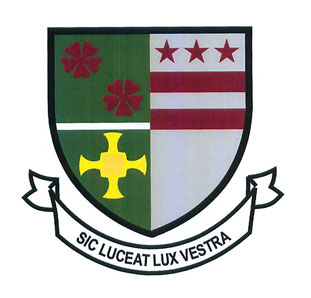 St Robert of Newminster Catholic School
St Robert of Newminster Catholic Schooland Sixth Form College
United Kingdom
Thinking Maps and School Effectiveness
A Study of a UK Comprehensive School
Impact of Thinking Maps®
Evidence gathered thus far is mainly anecdotal. According to teachers, the quality of essay writing appears to have improved as a result of maps being used as a planning tool. Furthermore, lesson observations have suggested that pupils participating in Thinking Map® activities have an improved on task behaviour.
As illustrated below, in one subject area, pupils who used maps to demonstrate their learning achieved higher coursework grades compared with those who didn’t. In a task where students were asked to compare and contrast then categorise their own ability against an ideal model, students in Group 1 opted to use a series of double-bubble and tree maps. Students in Group 2 opted to present their thinking in linear text. Extended written responses demonstrated that students in Group 1 outperformed those in Group 2. Coursework was externally moderated, providing measurable evidence that the use of Thinking Maps® supported improved student outcomes in this area.
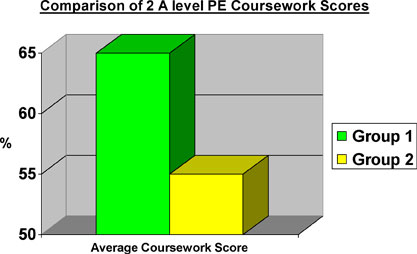
In the same subject area, Groups 1 and 2 were immersed in the use of Thinking Maps® whereas Groups 3 and 4’s experience was more sporadic. Particular emphasis of usage was given to the revision process where the visual representation of thinking appears to have facilitated greater understanding of the theoretical aspects of GCSE PE. As illustrated below, Groups 1 and 2, who went through this process, outperformed Groups 3 and 4. Furthermore, this cohort outperformed the previous year, who were examined before the implementation of Thinking Maps®.
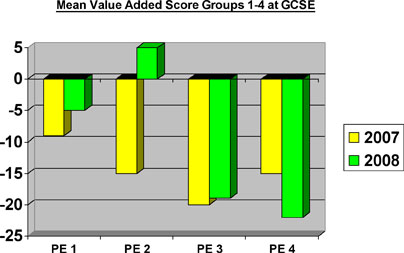
In a different subject area, Value Added Scores have improved since the implementation of Thinking Maps®. Illustrated below are the results of two parallel classes of average-ability students, taught by the same teacher before and after the implementation of Thinking Maps®. The 2006 class performed well, achieving a mean Value Added Score of 2 in English and 6 in English Literature. The 2008 class achieved a higher mean Value Added Score of 11 in English and 13 in English Literature. Results demonstrate that thinking skills activity approaches embedded in the teaching and learning of the 2006 class were complimented by the immersion of Thinking Maps® in 2008.
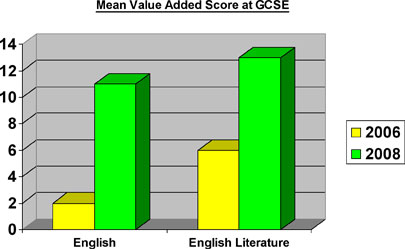
In a third subject area the introduction of Thinking Maps® as a teaching and learning strategy significantly contributed to improved learner performance. Illustrated below are the Value Added Scores for 23 learners over two externally marked Advanced Level examinations in Law. In January learners performed poorly with significant underachievement; however significant over achievement occurred in the July examinations. The immersion of learners in the use of Thinking Maps® as a visual tool resulted in more effective access by the teacher to learner thinking about the subject matter. This enabled a more effective use of scaffolding and signposting of learning which, when coupled with the technique of double processing of knowledge and understanding, played a significant role in enhancing learner performance.
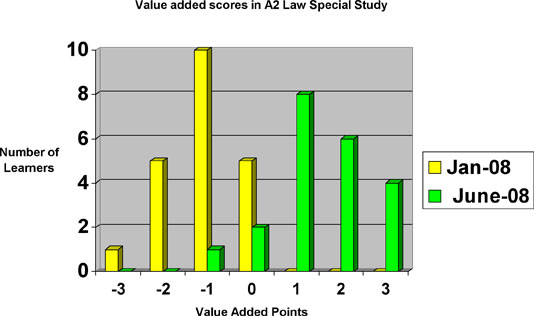
The Case Study sections are accessible in the links below and in the upper left column menu on each page of the St Robert Case Study.
- Project Overview
- Teacher Instructional and Higher Order Thinking Levels
- Teacher Methodologies
- Consistency and Frequency of Use
- Teacher Perceptions of Thinking Maps®
- Analysis of Pupils' Perceptions of Themselves as Learners
- Teacher Collaboration, Communication and Problem Solving
- Impact of Thinking Maps®
- Conclusion
- Video Clips
- Download Acrobat PDF copy of St. Robert Case Study